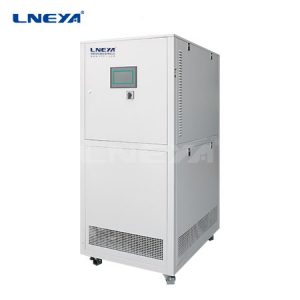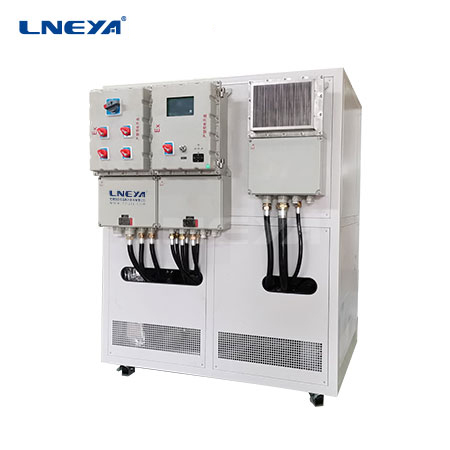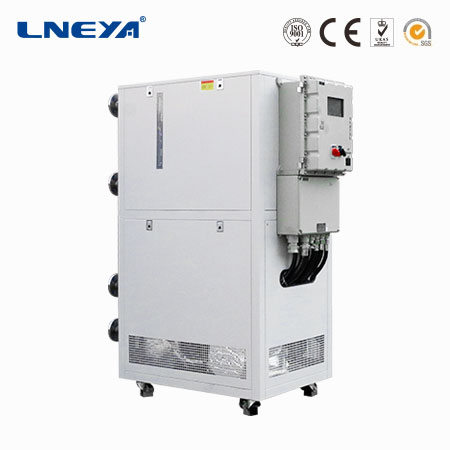Distillation tower process chiller heating system
Distillation towers and distillation tower processes indeed require chillers and heating systems to maintain temperature control during the process, ensuring effective separation and purification operations.
The top temperature of the tower is generally controlled within a lower range to ensure effective separation and purification. For example, for some general distillation operations, the top temperature of the tower may be controlled at around 79℃, but this is not an absolute value, which needs to be determined based on the boiling point of the separated substance and the operating pressure.
The bottom temperature of the tower needs to be higher than the boiling point of the lowest boiling component in the material, but it should not be too high to prevent the high boiling component from being evaporated in large quantities, which will affect the separation effect. Generally speaking, the bottom temperature of the tower may be controlled between 105 and 107℃, but the specific values need to be adjusted based on actual operating conditions and material characteristics.
Chiller function
Cooling reflux liquid: At the top of the distillation tower, the vapor is cooled into a liquid through the condenser, which is usually sent back to the top as reflux liquid to help maintain the gas-liquid balance and purification effect inside the tower. The cold water provided by the chiller flows through the condenser to effectively condense the steam.
Control the temperature at the top of the tower: By precisely controlling the cooling water volume and temperature entering the condenser through the chiller, the temperature at the top of the tower can be precisely adjusted, which is crucial for controlling the separation purity of the product.
Maintain system thermal balance: During distillation and distillation processes, a large amount of heat is generated, and the chiller helps to remove this excess heat, maintain the thermal balance of the entire system, and prevent efficiency reduction or equipment damage caused by overheating.
- MORE
LT -45℃~30℃
Industrial/Laboratory Air ChillerCOOLING TEMP -45℃~30℃Configuration DetailsProductDescriptionCooling MethodData Communication InterfaceAPPLICATION SCENARIOProduct Applicationsrecommend products LOW TEMPERATURE COOLING C…
- MORE
LT 10℃~30℃
Product data downloadConfiguration DetailsProductDescriptionCooling MethodData Communication InterfaceAPPLICATION SCENARIOProduct ApplicationsRecommend products Saving water resources & circulating cooling …
- MORE
LT -25℃~30℃
Low Temperature Air Cooled ChillerIndustry temperature control solutionLT series fixed frequency chillerASET control4.3 version screen100% safety regulations100% helium detectionTemperature range -80°C-30℃Secondary subcooling technologyConfigurat…
loading…
已经是到最后一篇内容了!
Heating system function
Provide heat: At the bottom of the tower, the heating system (usually a reboiler) heats the raw materials, promoting the evaporation of low boiling components and forming rising steam. The heat supply of the heating system must be sufficient and stable to ensure continuous distillation operations.
Control the temperature at the bottom of the tower: By adjusting the heating intensity, the temperature at the bottom of the tower can be controlled, which in turn affects the distillation rate and the evaporation efficiency of the materials. This is very important for controlling the vapor-liquid balance and separation effect of the materials inside the tower.
Promote material flow: Proper heating also helps with the flow of materials inside the tower, avoiding local overheating or prolonged material residence time, which can affect product quality.
- MORE
UC series
Support outlet temperature control of thermal conductive mediaThermal oil heating SystemTemp. Control 50~300℃, Accuracy of ±0.5°CConfiguration DetailsProductDescriptionMultiple equipment and wide applicationREQUEST A QUOTErecommend products …
- MORE
UST series
Parameters DetailedYou may also be interested in these products It is suitable for the needs of various process production and experimental use in pharmaceutical and chemical enterprises. It can realize high temperature cooling p…
loading…
已经是到最后一篇内容了!
In summary, chillers and heating systems play a crucial role in distillation and distillation processes. Chillers are responsible for condensation and cooling, while heating systems are responsible for evaporation and providing necessary heat. The collaboration between the two ensures the efficient and stable operation of the process and the high-quality separation of products.
 LNEYA Industrial Chillers Manufacturer Supplier -
LNEYA Industrial Chillers Manufacturer Supplier -
















